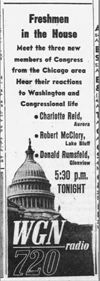It has been all but impossible to read  anything written about Lauren Underwood since she won election to Congress from IL-14 in November that doesn’t point out that she is the first woman, and first minority, to represent her district.
anything written about Lauren Underwood since she won election to Congress from IL-14 in November that doesn’t point out that she is the first woman, and first minority, to represent her district.
Which is true. She is.
But it is also not entirely true.
It all depends on how you read, or write, one of those “firsts.”
For example, I used to live in IL-14. I lived on Aurora’s east side for a year or so, I lived on Aurora’s west side for another four years, and then Boulder Hill after that. And if I was still living in IL-14 it would not be true that Lauren Underwood was the first woman representing me in Congress. That’s because I had a woman representing me in Congress the entire time I lived in Aurora. Her name was Charlotte Reid.
Charlotte Reid, from Aurora’s east side, served four terms in Congress, plus part of a fifth, from 1963 to 1971. Women were such a distinct minority in the House of Representatives then that it would be another quarter century after Reid was first elected before even 5% of House members were women. Reid even earned a “first” of her own: she was the first woman to wear pants on the House floor. It seems like a rather frivolous milestone today, but it was considered noteworthy at the time. Path breaking, even.
Now, it must be said, Charlotte Reid represented the 15th congressional district of Illinois, not the 14th. One might, therefore, reasonably protest that Underwood and Reid did not, in point of fact, represent the same district, and so Underwood’s “first woman” claim holds. And I would agree. Underwood’s 14th isn’t Reid’s 15th, no matter how much they overlap. But, I would add, Underwood’s 14th is also not the 14th that elected Randy Hultgren in 2010. Or Denny Hastert before that. Redistricting, remember, reinvents these districts every ten years now.
Go back much further and there’s no connection from one 14th to the next whatsoever. During the first half of the 20th century the 14th bordered the Mississippi River in western Illinois. !n the 1890s it ran through central Illinois. In the 1880s the Congressman for the 14th was from Danville, in east central Illinois. What significance is to be found, then, in such “firsts” in the history of a congressional district that has no coherent, meaningful history in the first place?
This is not to say that it is not important to elect more women, or minorities, or younger members of Congress. We should want our representatives in government to reflect the diversity of the people they represent, and so every step in the direction of a Congress that reflects the diversity of our country should be seen as a positive step. The special pleading that seeks to make too much of of a factoid best suited for a game of Trivial Pursuit, however, is something we can do without.
But I would like to take the argument further. The IL-14 of 2018 wasn’t the IL-14 of 2016, either. Sure, the boundaries were the same. But the prospect of electing a woman President for the first time in 2016 clearly attracted the interest, and enthusiastic support, of a segment of the electorate that had probably never been as excited by a presidential candidate as they were by Hillary Clinton. Then, despite the insult of the election of the thoroughly contemptible—and utterly misogynist—Donald Trump, that newly energized segment of the activist base stayed in the field, from the Women’s Marches, into the Indivisible movement, and on into volunteer work in the 2018 primary.
A new deck of cards was being played, and Lauren Underwood was dealt a winning hand. She was a dynamic, young, African-American woman in a crowded field of uninspiring, underachieving, (mostly) middle-aged, white men. In such a field, the most energized segment of the Democratic activist base was hers for the taking. She caught a wave, a big wave, and rode it to victory with great skill.
But what if there had been another woman in the field and Underwood had had serious competition for the pink-hatted contingent? Does anyone think she would have lapped the field in the primary as easily as she did if women voters, and volunteers, had faced a harder choice? Or what if her resume had come in the form of a Lawrence Underwood instead of a Lauren? Maybe Lawrence could have squeaked out a victory in the primary, but in the general? In a Republican vote sink like IL-14 that was designed by Mike Madigan to be thrown away to the GOP?
Implicit in the “first woman” talk, it seems to me, is the assumption that Lauren Underwood was elected to Congress in spite of her gender. That, in this still sexist world, a woman will face obstacles that a male candidate simply does not, the kind of obstacles a woman faces every day of her life, but men do not, and Underwood overcame all that. For my part, I think that is undeniably true. But isn’t it also possible that there is no way Lauren Underwood would have been elected to Congress from IL-14 in 2018 if she was not a woman? Because I think that’s true, too. And a “first” all it’s own that is worthy of note.
Tags: 2018 elections, Aurora IL, Charlotte Reid, IL-14, IL-15, Illinois, Lauren Underwood, U. S. House

